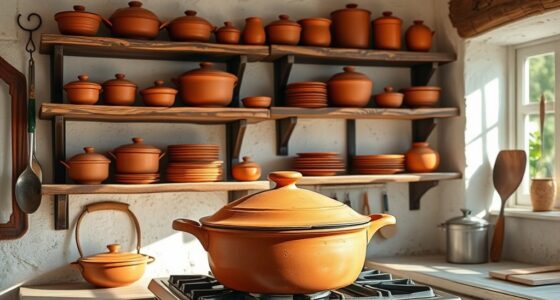In Emilia-Romagna, cured meats have a centuries-old tradition that showcases regional craftsmanship, local ingredients, and cultural pride. From prosciutto di Parma to mortadella, each product reflects unique techniques and recipes passed down through generations. Small producers and family farms uphold these methods, ensuring authentic flavors shaped by local climate and customs. If you continue exploring, you’ll discover the fascinating history behind these iconic regional specialties and the craftsmanship that keeps their legacy alive.
Key Takeaways
- Emilia-Romagna’s cured meats reflect centuries of regional tradition, culture, and craftsmanship.
- Local climate, geography, and customs shape unique production techniques for each product.
- Traditional recipes emphasize natural ingredients, precise curing times, and specific regional methods.
- Key cured meats like Prosciutto di Parma and mortadella showcase regional flavor profiles and craftsmanship.
- Preservation of heritage and authenticity is maintained through small-scale, family-run production practices.

Nestled in Italy’s culinary heart, Emilia-Romagna is renowned for its exceptional cured meats that embody centuries of tradition. When you explore the region’s cured meats, you’re diving into a world shaped by regional production and time-honored recipes passed down through generations. These meats are more than just food; they’re an expression of local culture, history, and craftsmanship.
In Emilia-Romagna, regional production plays a crucial role in maintaining the authenticity and quality of cured meats. Small-scale producers and family-run farms take pride in their methods, often sticking to traditional recipes that have stood the test of time. You’ll notice that each town or village might have its own distinctive approach, influenced by local climate, geography, and culinary customs. This regional diversity ensures that every cured meat you taste carries a unique story, rooted in its origins and production techniques. Whether it’s the delicate, age-old processes for making prosciutto di Parma or the flavorful, spice-rubbed salami from Bologna, the emphasis remains on preserving local flavors and craftsmanship.
As you sample these cured meats, you’ll appreciate the meticulous attention to detail that goes into their creation. Traditional recipes often call for specific cuts of meat, precise curing times, and natural ingredients that have been used for centuries. For instance, prosciutto di Parma is made from specially selected pigs, cured naturally with sea salt, and aged in controlled environments that mimic historical methods. This dedication to tradition ensures that each piece delivers a balanced flavor—rich, savory, and tender—reflecting the region’s culinary heritage. Similarly, mortadella, with its smooth texture and delicate aroma, is crafted using time-honored recipes that blend high-quality pork with carefully selected spices.
Frequently Asked Questions
How Have Curing Techniques Evolved Over Centuries in Emilia-Romagna?
You see, curing techniques in Emilia-Romagna have evolved through centuries with a focus on historical preservation and technological advancements. Traditional methods, like salt curing and air drying, remain essential, but modern tools now guarantee better control of temperature and humidity. This blend of old and new helps maintain authentic flavors while improving safety and consistency, allowing you to enjoy high-quality cured meats that honor history yet embrace innovation.
What Are the Regional Differences in Cured Meat Flavors Within Emilia-Romagna?
You’ll notice regional diversity in cured meat flavors across Emilia-Romagna, shaped by local traditions and ingredients. In Parma, expect delicate, buttery prosciutto, while Bologna offers more robust, seasoned salami. Modena’s cured meats feature intense, savory notes, and in Ferrara, you find milder, subtly spiced options. Each area’s unique climate and culinary heritage create distinct flavor profiles, making Emilia-Romagna a rich tapestry of cured meat varieties.
Which Traditional Festivals Celebrate Cured Meats in Emilia-Romagna?
Imagine vibrant festivals bursting with festive food and lively cultural celebrations. You’ll find these in Emilia-Romagna, where traditions honor cured meats through events like the Festa del Prosciutto di Parma and the Sagra del Culatello di Zibello. These festivals celebrate regional flavors, bringing communities together to enjoy cured meats, music, and local crafts—immersing you in the rich culinary heritage that makes Emilia-Romagna’s cultural celebrations truly unforgettable.
How Does Climate Influence Curing Processes in Emilia-Romagna?
You’ll notice that climate plays a key role in curing meats in Emilia-Romagna. Microclimate effects, like humidity and temperature, help create ideal conditions for seasonal curing, ensuring meats develop their rich flavors and textures. In colder seasons, curing slows down, enhancing flavor, while warmer months speed up the process. This natural variation allows artisans to tailor their techniques, resulting in authentic, high-quality cured meats that reflect regional climate influences.
Are There Modern Innovations Impacting Traditional Curing Methods?
You’re right on the mark—modern innovations are shaking things up. New packaging tech boosts food safety and extends shelf life, while innovative curing methods focus on consistency and quality. These advances help preserve Emilia-Romagna’s rich tradition without sacrificing safety or flavor. It’s a win-win situation, proving that even time-honored methods can adapt and thrive in today’s fast-paced world. Change is coming, but it respects the roots.
Conclusion
So, when you taste these cured meats, you’re not just savoring food—you’re experiencing a centuries-old symphony of flavors so rich, it’s practically a culinary time machine. Emilia-Romagna’s cured meats are so legendary, they could make even the most hardened food critic weep tears of joy. Once you’ve tried them, you’ll realize they’re not just part of the region’s history—they’re its heartbeat, pulsating with flavor so intense, it might just change your life forever.









